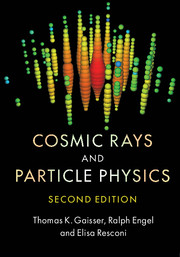Book contents
- Frontmatter
- Contents
- Preface to the first edition
- Preface to the second edition
- 1 Cosmic rays
- 2 Cosmic ray data
- 3 Particle physics
- 4 Hadronic interactions and accelerator data
- 5 Cascade equations
- 6 Atmospheric muons and neutrinos
- 7 Neutrino masses and oscillations
- 8 Muons and neutrinos underground
- 9 Cosmic rays in the Galaxy
- 10 Extragalactic propagation of cosmic rays
- 11 Astrophysical γ -rays and neutrinos
- 12 Acceleration
- 13 Supernovae in the Milky Way
- 14 Astrophysical accelerators and beam dumps
- 15 Electromagnetic cascades
- 16 Extensive air showers
- 17 Very high energy cosmic rays
- 18 Neutrino astronomy
- Appendix
- References
- Index
3 - Particle physics
Published online by Cambridge University Press: 05 June 2016
- Frontmatter
- Contents
- Preface to the first edition
- Preface to the second edition
- 1 Cosmic rays
- 2 Cosmic ray data
- 3 Particle physics
- 4 Hadronic interactions and accelerator data
- 5 Cascade equations
- 6 Atmospheric muons and neutrinos
- 7 Neutrino masses and oscillations
- 8 Muons and neutrinos underground
- 9 Cosmic rays in the Galaxy
- 10 Extragalactic propagation of cosmic rays
- 11 Astrophysical γ -rays and neutrinos
- 12 Acceleration
- 13 Supernovae in the Milky Way
- 14 Astrophysical accelerators and beam dumps
- 15 Electromagnetic cascades
- 16 Extensive air showers
- 17 Very high energy cosmic rays
- 18 Neutrino astronomy
- Appendix
- References
- Index
Summary
In this chapter we will give an overview of the modern understanding of particle physics, concentrating on aspects that are of direct relevance to the later discussions in this book. Comprehensive introductions to high-energy physics and the Standard Model of particle physics can be found in the textbooks, for example, by Halzen [34], Perkins [35] and Weinberg [36]. An up-to-date compilation of particle properties and related descriptions is provided by the PARTICLE DATA GROUP.
Historical relation of cosmic ray and particle physics
In the 1930s, the early years of particle physics, the observation of cosmic rays was the only means of studying energetic particles. While the first measurements of cosmic rays, such as the ionization rate of air, were of indirect nature, the use of cloud chambers in cosmic ray observations, pioneered by Skobelzyn in 1927, opened the way to image directly tracks of high-energy particles for the first time.
The first discovery of a new particle in the cosmic radiation was that of the positron by Anderson [37]. Using a lead absorber in a cloud chamber that was placed in a strong magnetic field allowed Anderson to determine not only the energy and charge but also the direction of the particle trajectory. After this serendipitous discovery systematic studies of the particle nature of cosmic rays and their interactions were carried out by many groups.
In the early experiments, not more than 2% of all cloud chamber pictures contained cosmic ray tracks. The development of fast electronic circuits that could be used to take pictures of cloud chambers in coincidence with Geiger tubes for triggering increased this efficiency to 80% and allowed systematic studies of particle trajectories. The much larger number of trajectories that could be observed with triggered experiments led to the discovery of e+e- pair production by Blackett and Occhialini [38] and the muon by Neddermeyer and Anderson [39]. Initially the muon was incorrectly identified as the pion predicted in Yukawa's theory of the strong interaction and given the name mesotron. Other particles discovered with cloud chambers are the and baryons [40, 41]. Furthermore, studying the coincidence rate of Geiger tubes placed at large distances from each other led to the discovery of air showers in high-altitude experiments [42–44]. The interpretation within cascade theory showed already at that time that some cosmic rays must have energies of 1015 eV or higher
- Type
- Chapter
- Information
- Cosmic Rays and Particle Physics , pp. 30 - 64Publisher: Cambridge University PressPrint publication year: 2016

